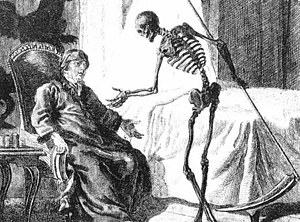Kematian (personifikasi)
Tampilan
(Dialihkan dari Grim Reaper)


Konsep Kematian sebagai entitas hidup telah ada di banyak masyarakat sejak awal sejarah. Dalam bahasa Inggris, kematian sering diberi nama Grim Reaper dan, sejak abad ke-15, ditampilkan sebagai sosok kerangka membawa sabit besar dan mengenakan jubah hitam dengan kerudung. Hal ini juga diberi nama Malaikat Maut (Malach HaMavet) atau Iblis Kematian atau malaikat gelap dan terang yang berasal dari Alkitab dan tradisis Talmud. Alkitab sendiri tidak merujuk pada "Malaikat Kematian" ketika ia pertama kali muncul di Mesir. Ada juga referensi untuk "Abaddon" (Penghancur), seorang malaikat yang dikenal sebagai "Malaikat Jurang Maut". Dalam pengetahuan Talmud, dia ditandai sebagai malaikat utama Samael.[1]
Bibliografi
[sunting | sunting sumber]- Bender, A. P. (1894). "Beliefs, Rites, and Customs of the Jews, Connected with Death, Burial, and Mourning". The Jewish Quarterly Review. 6 (2): 317–347. doi:10.2307/1450143. JSTOR 1450143.
- Bender, A. P. (1894). "Beliefs, Rites, and Customs of the Jews, Connected with Death, Burial, and Mourning". The Jewish Quarterly Review. 6 (4): 664–671. doi:10.2307/1450184. JSTOR 1450184.
- Böklen, Ernst (1902). Die Verwandtschaft der Jüdisch-Christlichen mit der Parsischen Eschatologie. Göttingen: Vendenhoeck & Ruprecht.
- Dillmann, August (1895). Handbuch der alttestamentlichen Theologie. Leipzig: S. Hirzel.
- Gordon, Maurice Bear (December 1941). "Medicine among the Ancient Hebrews". Isis. 33 (4): 454–485. doi:10.1086/358601. JSTOR 330623.
- Hamburger, J[acob] (1884). "Tod". Real-Encyclopädie für Bibel und Talmud: Wörterbuch zum handgebrauch für Bibelfreunde, Theologen, Juristen, Gemeinde- und Schulvorsteher, Lehrer &c (dalam bahasa German). 1. Strelitz, Mecklenburg: Selbstverlag des Verfassers. hlm. 990–992. OCLC 234124918. Diakses tanggal 3 March 2013.
- Joël, David (1881). Der Aberglaube und die Stellung des Judenthums zu Demselben. Breslau: F.W. Jungfer's Buch.
- Artikel ini memadukan teks dari Jewish Encyclopedia 1901–1906 article "Angel of Death" by Kaufmann Kohler and Ludwig Blau, sebuah terbitan yang kini berada di ranah publik.
- Kohut, Alexander (1866). Ueber die Jüdische Angelologie und Dämonologie in Ihrer Abhängigkeit vom Parsismus. Leipzig: Brockhaus.
- Lynette, Rachel (2009). The Grim Reaper. Monsters. Farmington Hills, MI: KidHaven Press. ISBN 9780737745689. OCLC 317921894.
- Milton, John. Paradise Lost.
- Olyan, Saul M. (1993). A Thousand Thousands Served Him: Exegesis and the Naming of Angels in Ancient Judaism. Texte und Studien zum antiken Judentum, 36. Tübingen: J.C.B. Mohr. ISBN 9783161460630. OCLC 28328810.
- Schwab, Moïse (1897). Vocabulaire de l'Angélologie d'Après les Manuscrits Hebreux de la Bibliothèque Nationale. Paris.
- Stave, Erik (1898). Ueber den Einfluss des Parsismus auf das Judenthum. Haarlem: E. F. Bohn.
- Weber, F. W. (1897). Jüdische Theologie auf Grund des Talmud und verwandter Schriften, gemeinfasslich dargestellt. Leipzig: Dörffling & Franke.
- Winer, Georg Benedikt (1848). "Satan". Biblisches Realwörterbuch zum Handgebrauch für Studirende, Kandidaten, Gymnasiallehrer und Prediger (dalam bahasa German). 2 (edisi ke-third). Leipzig: Carl Heinrich Reclam. hlm. 383–386. OCLC 311684816. Diakses tanggal 3 March 2013.
- Hunter, Dave. Reapers inc.
Referensi
[sunting | sunting sumber]- ^ Bunson, Matthew, (1996). Angels A to Z: A Who's Who of the Heavenly Host. Three Rivers Press. ISBN 0-517-88537-9.
Pranala luar
[sunting | sunting sumber]Wikimedia Commons memiliki media mengenai personification of Death.
- Korea National Encyclopedia of Ethnic Practices Diarsipkan 2015-06-10 di Wayback Machine. (Korea)
